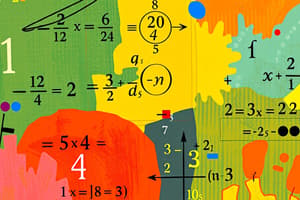Podcast
Questions and Answers
What is the formula to calculate total distance traveled if the initial velocity is known?
What is the formula to calculate total distance traveled if the initial velocity is known?
- $s = vt^2$
- $s = 2vt$
- $s = v^2t$
- $s = vt + 16t$ (correct)
Which formula gives the area of a trapezoid?
Which formula gives the area of a trapezoid?
- $A = \frac{S(a + l)}{2}$
- $A = a^2 + l^2$
- $A = \frac{h(a + l)}{2}$ (correct)
- $A = a + l$
To find the average speed, which formula would you use?
To find the average speed, which formula would you use?
- $v = d - t$
- $v = \frac{d}{t}$ (correct)
- $v = d + t$
- $v = d^2 + t^2$
When calculating compound interest, which of the provided formulas is correct?
When calculating compound interest, which of the provided formulas is correct?
How is 'r' derived in the formula for the radius of a circle?
How is 'r' derived in the formula for the radius of a circle?
What does the formula $m = \frac{a - rl}{n}$ calculate?
What does the formula $m = \frac{a - rl}{n}$ calculate?
Which of the following represents the formula to find the area of a rectangle?
Which of the following represents the formula to find the area of a rectangle?
How can you express the velocity in terms of acceleration and time?
How can you express the velocity in terms of acceleration and time?
What is the value of $r$ in the equation $C = 2πr$?
What is the value of $r$ in the equation $C = 2πr$?
In the formula $A = \frac{1}{2}bh$, what must be true for $h$?
In the formula $A = \frac{1}{2}bh$, what must be true for $h$?
For the equation $S = \frac{a+l}{2}h$, what variable represents the area of a trapezoid?
For the equation $S = \frac{a+l}{2}h$, what variable represents the area of a trapezoid?
From the equation $F = f + g - d$, which variable accounts for the loss or gain?
From the equation $F = f + g - d$, which variable accounts for the loss or gain?
In the formula $v^2 = u^2 + 2as$, which component represents final velocity?
In the formula $v^2 = u^2 + 2as$, which component represents final velocity?
When isolating $a$ in the equation $a = \frac{180(n-2)}{n}$, which condition is crucial for $n$?
When isolating $a$ in the equation $a = \frac{180(n-2)}{n}$, which condition is crucial for $n$?
What is the form of $w$ when rearranging $p = 2(l + w)$?
What is the form of $w$ when rearranging $p = 2(l + w)$?
To isolate $s$ in $v = u + 2as$, which expression rearranges correctly?
To isolate $s$ in $v = u + 2as$, which expression rearranges correctly?
What is the formula for calculating 'w' when given 'p' and 'l'?
What is the formula for calculating 'w' when given 'p' and 'l'?
Which equation correctly represents the calculation of 's'?
Which equation correctly represents the calculation of 's'?
How is 'n' defined in relation to 'd' and 'K'?
How is 'n' defined in relation to 'd' and 'K'?
What condition must be met to calculate 'r' accurately?
What condition must be met to calculate 'r' accurately?
Which equation relates 'y' to 'x' and 'm'?
Which equation relates 'y' to 'x' and 'm'?
What is the function of 'a' derived from 'S' and 'n'?
What is the function of 'a' derived from 'S' and 'n'?
Which constraint is necessary when computing 'l' from 'r'?
Which constraint is necessary when computing 'l' from 'r'?
In the context of the formula F = 5C + 32, what is the relationship of F to C?
In the context of the formula F = 5C + 32, what is the relationship of F to C?
Flashcards are hidden until you start studying
Study Notes
Solving Equations
- The text provides practice problems for solving equations with a specific variable as a subject.
- The goal is to manipulate the equations by rearranging them.
- The answer must also include restrictions, as certain values for specified variables can make the equation invalid.
- Restrictions are defined as exclusions where the denominator of a fraction cannot equal 0.
- The text includes both basic and more challenging problems.
- The challenge questions may require factoring to isolate the required variable.
Examples of Problem Types
- Rearranging simple equations:
- Example: C = 2πr, where you need to solve for r.
- Rearranging equations with fractions:
- Example: v^2 = u^2 + 2as, where you need to solve for s.
- Rearranging equations with multiple variables:
- Example: a = 180(n - 2)/n, where you need to solve for n.
Tips for Solving Equations
- Identify the variable you need to isolate.
- Use inverse operations to move terms around the equation.
- Remember to consider restrictions on the variables.
- Factor if necessary.
Additional Practice
- The text provides additional practice problems for solving equation for a specific variable.
- These problems follow a similar structure to the initial problems.
- The answers to the additional practice problems are provided for students to check their understanding and provide additional examples of the types of equations to be solved.
Studying That Suits You
Use AI to generate personalized quizzes and flashcards to suit your learning preferences.




